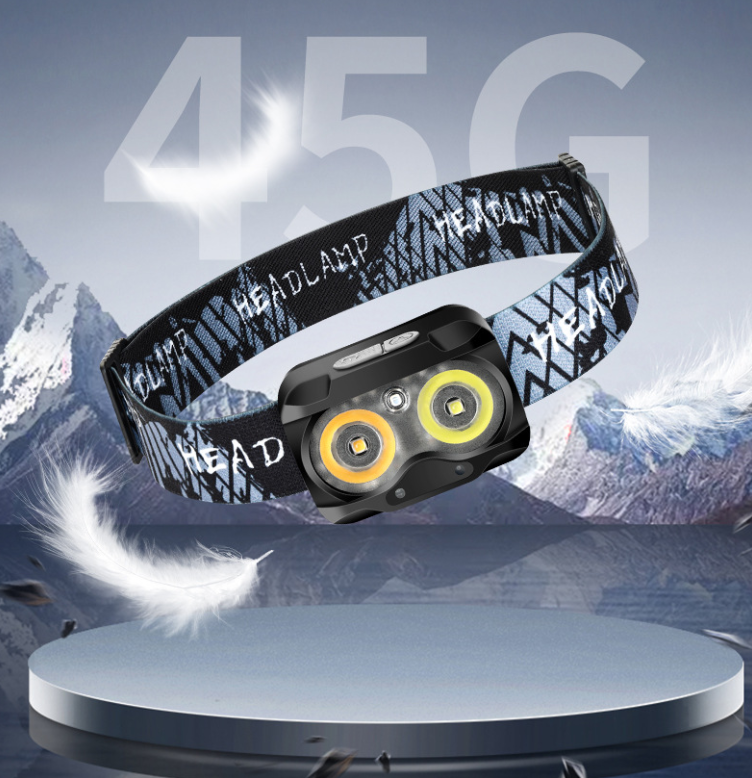Headlamps play a vital role in improving visibility when working or traveling in low-light conditions. While the ANSI/ISEA 107 standard primarily addresses high-visibility clothing, headlamps can significantly enhance your safety by complementing compliant apparel. Studies show that vehicles with well-rated headlights experience a 19% lower rate of nighttime crashes compared to those with poorly rated ones. High-beam lights also improve visibility, helping you detect hazards more effectively. Choosing ANSI 107 compliant headlamps ensures you stay visible and safe in challenging environments.
Key Takeaways
- Pick ANSI 107 headlamps to stay safe in dim light.
- Find headlamps with shiny or bright materials for better visibility.
- Check how bright, strong, and tough the headlamps are.
- Look for labels to make sure they meet safety rules.
- Using high-visibility headlamps lowers accident chances and follows work rules.
Understanding ANSI/ISEA 107 Standards
What the Standard Covers
The ANSI/ISEA 107 standard outlines specific requirements for high-visibility safety apparel (HVSA). These guidelines ensure workers remain visible in low-light or hazardous environments. The standard specifies the placement and amount of high-visibility materials to provide 360-degree visibility. It also defines the configuration and width of reflective bands, ensuring they meet minimum performance criteria.
To comply, garments must use fluorescent materials in colors like yellow-green, orange-red, or red. Reflective tape or striping enhances visibility further, especially in low-light conditions. Accredited laboratories test all apparel to confirm compliance. These tests assess durability, visibility, and the ability to withstand environmental factors like rain or heat. By meeting these criteria, HVSA ensures safety and reliability in demanding work environments.
High-Visibility Requirements for Accessories
Accessories, while not the primary focus of ANSI/ISEA 107, play a crucial role in enhancing visibility. Items like gloves, hats, and headlamps can complement high-visibility clothing. For accessories to align with the standard, they should incorporate reflective or fluorescent materials. These materials improve visibility from multiple angles, especially in dynamic environments.
Headlamps, for example, can provide additional illumination and visibility. When paired with compliant apparel, they create a comprehensive safety solution. Accessories must also demonstrate durability and resistance to environmental factors, ensuring they perform reliably in challenging conditions.
Relevance of ANSI 107 Compliant Headlamps
Although headlamps are not explicitly covered under the ANSI/ISEA 107 standard, they can significantly enhance safety. ANSI 107 compliant headlamps improve visibility by combining brightness with reflective or fluorescent properties. This makes them ideal for low-light or hazardous environments.
In workplaces near traffic or heavy machinery, these headlamps reduce the risk of accidents. They ensure you remain visible to others, even in poor lighting. By choosing headlamps that align with ANSI/ISEA 107 principles, you enhance your safety and meet workplace requirements. This makes them an essential addition to your high-visibility gear.
Key Criteria for ANSI 107 Compliant Headlamps
Brightness and Beam Intensity
When evaluating headlamps, brightness and beam intensity are critical factors. Brightness is measured in lux, which quantifies the amount of light visible at a specific distance. For example, industrial light meters measure maximum brightness at four meters. Beam intensity, on the other hand, determines how far the light travels. The formula for calculating illuminance (E) in lux is E = i / (D²), where “i” represents luminous intensity in candela, and “D” is the distance in meters. This ensures you can assess whether a headlamp provides sufficient illumination for your needs.
Standards like ANSI FL-1 also evaluate beam distance and battery runtime. These metrics help you choose headlamps that maintain consistent brightness over extended periods. A headlamp with high lux measurements and optimized beam distance ensures better visibility, especially in low-light environments. ANSI 107 compliant headlamps often excel in these areas, making them a reliable choice for safety.
Reflective and Fluorescent Properties
Reflective and fluorescent materials enhance visibility by making you more noticeable in dim conditions. Fluorescent colors like yellow-green or orange-red stand out during the day, while reflective elements improve visibility at night. Headlamps with reflective bands or fluorescent accents complement high-visibility clothing, ensuring you remain visible from multiple angles.
These properties are especially important in dynamic environments, such as construction sites or roadways. By choosing headlamps with reflective or fluorescent features, you create a comprehensive safety solution. This aligns with the principles of ANSI 107 compliant headlamps, which prioritize visibility and safety.
Durability and Environmental Resistance
Durability ensures your headlamp performs reliably under challenging conditions. Standardized tests, such as photometric and environmental testing, evaluate a headlamp’s ability to withstand stress. Photometric testing measures light intensity and distribution, while environmental testing assesses performance under extreme temperatures, humidity, and vibrations.
For example, FMVSS 108 outlines requirements for automotive lighting systems, including headlamps. Durability testing subjects headlamps to mechanical and environmental stresses, ensuring they can handle real-world conditions. ANSI 107 compliant headlamps often meet these rigorous standards, offering long-lasting performance and safety.
Why High-Visibility Compliance Matters
Safety in Low-Light Conditions
High-visibility compliance plays a crucial role in keeping you safe in low-light environments. Proper lighting and visibility reduce the likelihood of accidents, especially in areas with poor illumination. Research shows that well-designed road lighting can lower nighttime accidents by up to 30%. Roads with luminance levels between 1.2–2 cd/m² experience 20–30% fewer accidents compared to those with lower luminance levels. This highlights the importance of using tools like ANSI 107 compliant headlamps to enhance visibility and safety.
Headlamps with high brightness and reflective properties ensure you remain visible to others, even in dim conditions. Whether you are working on a construction site or walking along a poorly lit road, these headlamps provide the illumination needed to avoid hazards. By prioritizing visibility, you significantly reduce the risks associated with low-light environments.
Workplace and Legal Requirements
Many workplaces require you to meet specific safety standards, including high-visibility compliance. Industries like construction, transportation, and roadside maintenance often operate in hazardous conditions where visibility is critical. Employers must ensure workers use equipment that aligns with safety regulations to minimize risks and adhere to legal requirements.
Using ANSI 107 compliant headlamps demonstrates your commitment to workplace safety. These headlamps not only improve your visibility but also help organizations meet compliance standards. This reduces liability and ensures a safer working environment for everyone involved.
Reducing Risks in Hazardous Environments
Hazardous environments demand reliable safety measures to protect you from potential dangers. High-visibility headlamps play a vital role in reducing operational risks. A study examining the relationship between headlamp visibility and crash rates found that better headlight designs can lower nighttime crash rates by 12% to 29%. Improved visibility reduces the likelihood of accidents, ensuring safer operations in challenging conditions.
| Aspect | Details |
|---|---|
| Study Purpose | Examine the relationship between headlight visibility and real-world crash occurrence. |
| Methodology | Poisson regression to estimate effects on nighttime single-vehicle crashes per vehicle mile traveled. |
| Key Findings | Better headlight visibility correlates with lower nighttime crash rates. A reduction of 10 visibility demerits can reduce crash rates by 4.6%. Good-rated headlights can reduce crash rates by 12% to 29%. |
| Conclusion | IIHS evaluation encourages headlight designs that lower nighttime crash risks, enhancing safety for organizations. |
By choosing headlamps designed for high-visibility compliance, you protect yourself and others in hazardous environments. These headlamps ensure you remain visible, even in the most challenging conditions, reducing the risk of accidents and injuries.
How to Evaluate Headlamps for Compliance
Checking for Certification Labels
When evaluating headlamps for compliance, certification labels provide a quick way to verify their quality and adherence to safety standards. Look for labels such as FMVSS 108, which ensures the headlamp meets Federal Motor Vehicle Safety Standards for lighting and reflectors. These certifications confirm that the product has undergone rigorous testing for visibility and safety.
Accreditation bodies like Intertek, VCA, A2LA, and AMECA test automotive lighting products to ensure they meet industry standards. By checking for these labels, you can confidently select headlamps that align with high-visibility requirements. This step not only ensures safety but also helps you avoid products that fail to meet essential performance criteria.
Conducting Visibility and Reflectivity Tests
Testing the visibility and reflectivity of headlamps ensures they perform effectively in real-world conditions. Start by mounting the headlamp in a test fixture to replicate its actual installation. Then, conduct photometric measurements to evaluate light distribution and intensity. Analyze the beam patterns for both low and high beam functions to ensure proper illumination and glare control.
You should also verify the color consistency and brightness levels of the light output. Environmental testing, such as assessing performance under temperature changes and humidity, ensures durability. The table below outlines a step-by-step guide for evaluating headlamp compliance:
| Step | Description |
|---|---|
| 1 | Mount the product in a custom test fixture to replicate real-world installation. |
| 2 | Conduct photometric measurements to evaluate light distribution and intensity. |
| 3 | Analyze beam patterns for both low and high beam functions. |
| 4 | Verify color consistency and brightness levels. |
| 5 | Perform environmental and durability testing under various conditions. |
These tests ensure the headlamp meets visibility and safety standards, providing reliable performance in low-light environments.
Upgrading to ANSI 107 Compliant Headlamps
Upgrading to high-visibility headlamps offers significant safety and cost benefits. Halogen bulbs, for instance, cost $15 to $30 each and can be installed yourself, saving on labor costs. However, HID bulbs, priced at $100 to $150 each, require professional installation, adding $50 to $200. Despite the higher initial cost, HID bulbs are more energy-efficient and last longer, reducing replacement frequency. Over five years, halogen bulbs may cost around $150, while HID bulbs total approximately $300, including installation.
The long-term benefits of upgrading outweigh the initial expenses. HID bulbs provide better illumination, enhancing visibility and reducing accident risks. By investing in high-quality headlamps, you ensure safety and compliance with workplace or legal requirements.
Headlamps may not fall directly under ANSI/ISEA 107 standards, but they remain essential for improving visibility and safety. You should evaluate headlamps based on three key factors: brightness, reflectivity, and durability. These features ensure your headlamp works seamlessly with high-visibility apparel, creating a safer environment in low-light or hazardous conditions.
Post time: Mar-10-2025
 fannie@nbtorch.com
fannie@nbtorch.com +0086-0574-28909873
+0086-0574-28909873







